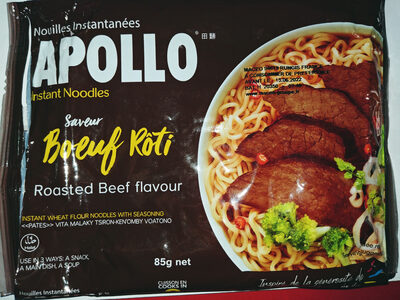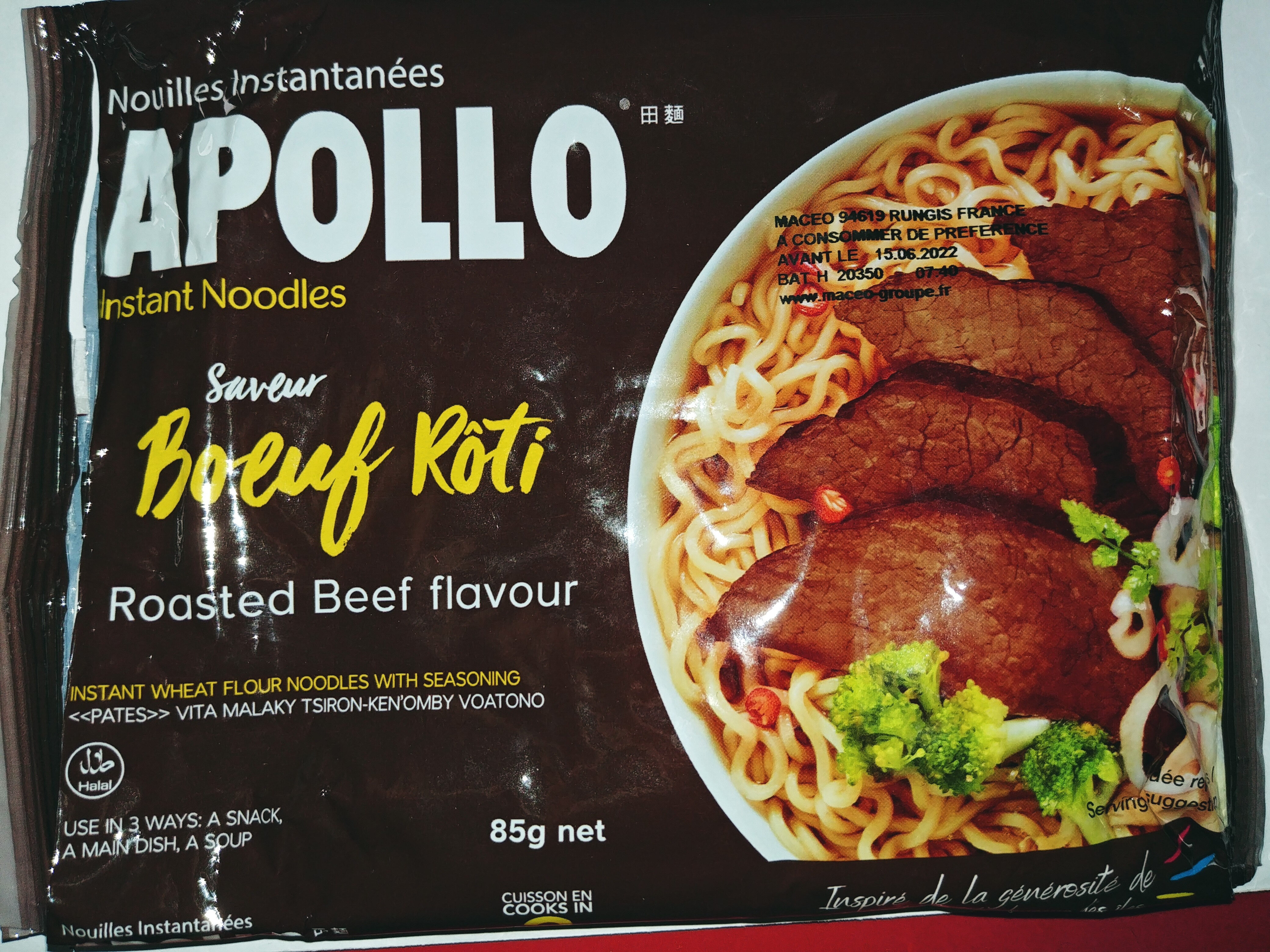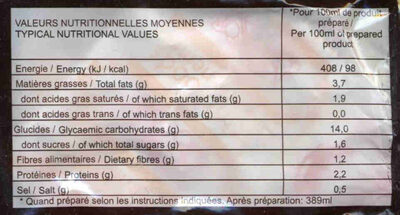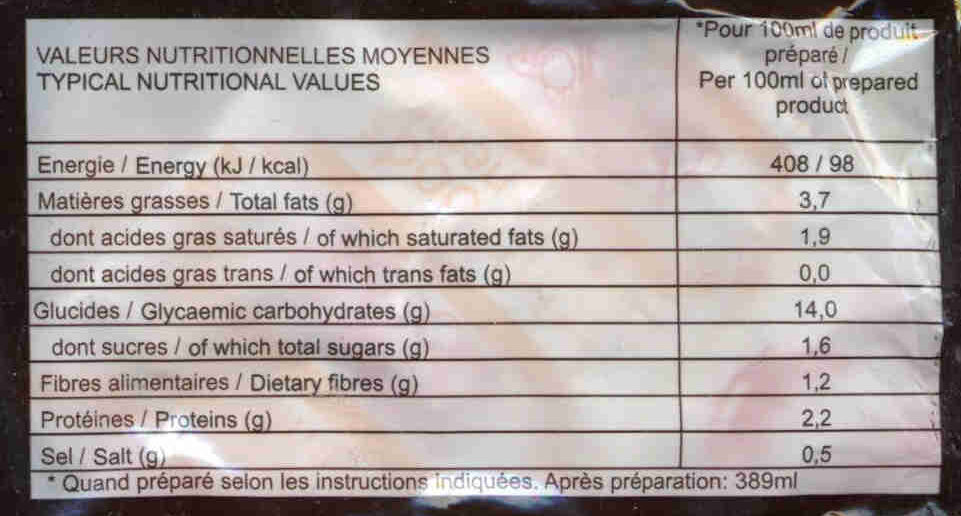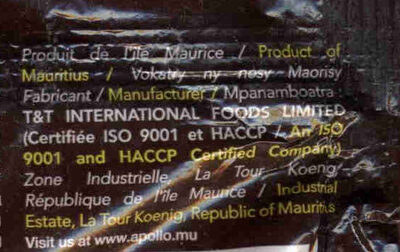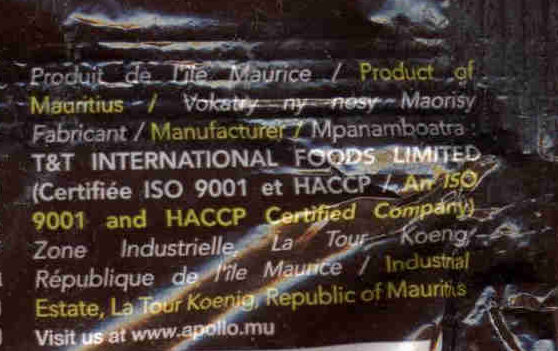Help us make food transparency the norm!
As a non-profit organization, we depend on your donations to continue informing consumers around the world about what they eat.
The food revolution starts with you!
Nouilles Instanées - Saveur Boeuf Rôti - Apollo - 85 g
Nouilles Instanées - Saveur Boeuf Rôti - Apollo - 85 g
This product page is not complete. You can help to complete it by editing it and adding more data from the photos we have, or by taking more photos using the app for Android or iPhone/iPad. Thank you!
×
Barcode: 6091091001681 (EAN / EAN-13)
Quantity: 85 g
Packaging: Plastic, Bag, Individual bag
Brands: Apollo
Categories: Plant-based foods and beverages, Plant-based foods, Cereals and potatoes, Cereals and their products, Dried products, Pastas, Dried products to be rehydrated, Noodles, Instant noodles
Labels, certifications, awards:
Halal, HACCP, ISO 9001
Manufacturing or processing places: Ile Maurice
Stores: Intermarché, Auchan, Carrefour
Countries where sold: France
Matching with your preferences
Health
Ingredients
-
26 ingredients
: Farine de blé (gluten), huile végétale (huile de palme raffinée [BHQT]), sel, correcteurs d'acidité: E501, E500, épaississant E466. SACHET D'ASSAISONNEMENT: Sel, glutamate de monosodium, exhausteur de goût: E621, sucre, arôme de boeuf, extraits de sauce soja, amidon de maïs, caséinate de sodium (lait), poivre, gingembre, anis, piment. SACHET DE PIMENT: Poudre de piment.Allergens: Gluten, MilkTraces: Celery, Crustaceans, Fish, Milk, Sesame seeds, Soybeans
Food processing
-
Ultra processed foods
Elements that indicate the product is in the 4 - Ultra processed food and drink products group:
- Additive: E466 - Sodium carboxy methyl cellulose
- Additive: E621 - Monosodium glutamate
- Ingredient: Flavour enhancer
- Ingredient: Flavouring
- Ingredient: Thickener
Food products are classified into 4 groups according to their degree of processing:
- Unprocessed or minimally processed foods
- Processed culinary ingredients
- Processed foods
- Ultra processed foods
The determination of the group is based on the category of the product and on the ingredients it contains.
Additives
-
E319 - Tertiary-butylhydroquinone (tbhq)
Tert-Butylhydroquinone: tert-Butylhydroquinone -TBHQ, tertiary butylhydroquinone- is a synthetic aromatic organic compound which is a type of phenol. It is a derivative of hydroquinone, substituted with a tert-butyl group.Source: Wikipedia
-
E466 - Sodium carboxy methyl cellulose
Carboxymethyl cellulose: Carboxymethyl cellulose -CMC- or cellulose gum or tylose powder is a cellulose derivative with carboxymethyl groups --CH2-COOH- bound to some of the hydroxyl groups of the glucopyranose monomers that make up the cellulose backbone. It is often used as its sodium salt, sodium carboxymethyl cellulose.Source: Wikipedia
-
E500 - Sodium carbonates
Sodium carbonates (E500) are compounds commonly used in food preparation as leavening agents, helping baked goods rise by releasing carbon dioxide when they interact with acids.
Often found in baking soda, they regulate the pH of food, preventing it from becoming too acidic or too alkaline. In the culinary world, sodium carbonates can also enhance the texture and structure of foods, such as noodles, by modifying the gluten network.
Generally recognized as safe, sodium carbonates are non-toxic when consumed in typical amounts found in food.
-
E501 - Potassium carbonates
Potassium carbonate: Potassium carbonate -K2CO3- is a white salt, which is soluble in water -insoluble in ethanol- and forms a strongly alkaline solution. It can be made as the product of potassium hydroxide's absorbent reaction with carbon dioxide. It is deliquescent, often appearing a damp or wet solid. Potassium carbonate is used in the production of soap and glass.Source: Wikipedia
-
E621 - Monosodium glutamate
Monosodium glutamate: Monosodium glutamate -MSG, also known as sodium glutamate- is the sodium salt of glutamic acid, one of the most abundant naturally occurring non-essential amino acids. Glutamic acid is found naturally in tomatoes, grapes, cheese, mushrooms and other foods.MSG is used in the food industry as a flavor enhancer with an umami taste that intensifies the meaty, savory flavor of food, as naturally occurring glutamate does in foods such as stews and meat soups. It was first prepared in 1908 by Japanese biochemist Kikunae Ikeda, who was trying to isolate and duplicate the savory taste of kombu, an edible seaweed used as a base for many Japanese soups. MSG as a flavor enhancer balances, blends, and rounds the perception of other tastes.The U.S. Food and Drug Administration has given MSG its generally recognized as safe -GRAS- designation. A popular belief is that large doses of MSG can cause headaches and other feelings of discomfort, known as "Chinese restaurant syndrome," but double-blind tests fail to find evidence of such a reaction. The European Union classifies it as a food additive permitted in certain foods and subject to quantitative limits. MSG has the HS code 29224220 and the E number E621.Source: Wikipedia
Ingredients analysis
-
Palm oil
Ingredients that contain palm oil: Refined palm oil
-
Non-vegan
Non-vegan ingredients: Beef flavouring, Sodium caseinateSome ingredients could not be recognized.
We need your help!
You can help us recognize more ingredients and better analyze the list of ingredients for this product and others:
- Edit this product page to correct spelling mistakes in the ingredients list, and/or to remove ingredients in other languages and sentences that are not related to the ingredients.
- Add new entries, synonyms or translations to our multilingual lists of ingredients, ingredient processing methods, and labels.
If you would like to help, join the #ingredients channel on our Slack discussion space and/or learn about ingredients analysis on our wiki. Thank you!
-
Non-vegetarian
Non-vegetarian ingredients: Beef flavouringSome ingredients could not be recognized.
We need your help!
You can help us recognize more ingredients and better analyze the list of ingredients for this product and others:
- Edit this product page to correct spelling mistakes in the ingredients list, and/or to remove ingredients in other languages and sentences that are not related to the ingredients.
- Add new entries, synonyms or translations to our multilingual lists of ingredients, ingredient processing methods, and labels.
If you would like to help, join the #ingredients channel on our Slack discussion space and/or learn about ingredients analysis on our wiki. Thank you!
-
Details of the analysis of the ingredients
We need your help!
Some ingredients could not be recognized.
We need your help!
You can help us recognize more ingredients and better analyze the list of ingredients for this product and others:
- Edit this product page to correct spelling mistakes in the ingredients list, and/or to remove ingredients in other languages and sentences that are not related to the ingredients.
- Add new entries, synonyms or translations to our multilingual lists of ingredients, ingredient processing methods, and labels.
If you would like to help, join the #ingredients channel on our Slack discussion space and/or learn about ingredients analysis on our wiki. Thank you!
: Farine de blé, huile végétale (huile de palme raffinée (BHQT)), sel, correcteurs d'acidité (e501), e500, épaississant (e466, SACHET D'ASSAISONNEMENT), Sel, glutamate de monosodium, exhausteur de goût (e621), sucre, arôme de boeuf, sauce soja, amidon de maïs, caséinate de sodium, poivre, gingembre, anis, piment, SACHET DE PIMENT (piment)- Farine de blé -> en:wheat-flour - vegan: yes - vegetarian: yes - ciqual_proxy_food_code: 9410 - percent_min: 16.4675 - percent_max: 100
- huile végétale -> en:vegetable-oil - vegan: yes - vegetarian: yes - from_palm_oil: maybe - percent_min: 0 - percent_max: 50
- huile de palme raffinée -> en:refined-palm-oil - vegan: yes - vegetarian: yes - from_palm_oil: yes - ciqual_food_code: 16150 - percent_min: 0 - percent_max: 50
- BHQT -> en:e319 - vegan: yes - vegetarian: yes - percent_min: 0 - percent_max: 50
- huile de palme raffinée -> en:refined-palm-oil - vegan: yes - vegetarian: yes - from_palm_oil: yes - ciqual_food_code: 16150 - percent_min: 0 - percent_max: 50
- sel -> en:salt - vegan: yes - vegetarian: yes - ciqual_food_code: 11058 - percent_min: 0 - percent_max: 1.9725
- correcteurs d'acidité -> en:acidity-regulator - percent_min: 0 - percent_max: 1.9725
- e501 -> en:e501 - vegan: yes - vegetarian: yes - percent_min: 0 - percent_max: 1.9725
- e500 -> en:e500 - vegan: yes - vegetarian: yes - percent_min: 0 - percent_max: 1.9725
- épaississant -> en:thickener - percent_min: 0 - percent_max: 1.9725
- e466 -> en:e466 - vegan: yes - vegetarian: yes - percent_min: 0 - percent_max: 1.9725
- SACHET D'ASSAISONNEMENT -> en:condiment - vegan: maybe - vegetarian: maybe - percent_min: 0 - percent_max: 0.98625
- Sel -> en:salt - vegan: yes - vegetarian: yes - ciqual_food_code: 11058 - percent_min: 0 - percent_max: 1.9725
- glutamate de monosodium -> fr:glutamate-de-monosodium - percent_min: 0 - percent_max: 1.9725
- exhausteur de goût -> en:flavour-enhancer - percent_min: 0 - percent_max: 1.9725
- e621 -> en:e621 - vegan: yes - vegetarian: yes - percent_min: 0 - percent_max: 1.9725
- sucre -> en:sugar - vegan: yes - vegetarian: yes - ciqual_proxy_food_code: 31016 - percent_min: 0 - percent_max: 1.9725
- arôme de boeuf -> en:beef-flavouring - vegan: no - vegetarian: no - percent_min: 0 - percent_max: 1.9725
- sauce soja -> en:soy-sauce - vegan: maybe - vegetarian: maybe - ciqual_food_code: 11104 - percent_min: 0 - percent_max: 1.9725
- amidon de maïs -> en:corn-starch - vegan: yes - vegetarian: yes - ciqual_food_code: 9510 - percent_min: 0 - percent_max: 1.9725
- caséinate de sodium -> en:sodium-caseinate - vegan: no - vegetarian: yes - percent_min: 0 - percent_max: 1.9725
- poivre -> en:pepper - vegan: yes - vegetarian: yes - percent_min: 0 - percent_max: 1.9725
- gingembre -> en:ginger - vegan: yes - vegetarian: yes - ciqual_food_code: 11074 - percent_min: 0 - percent_max: 1.9725
- anis -> en:aniseed - vegan: yes - vegetarian: yes - percent_min: 0 - percent_max: 1.9725
- piment -> en:chili-pepper - vegan: yes - vegetarian: yes - ciqual_food_code: 20151 - percent_min: 0 - percent_max: 1.9725
- SACHET DE PIMENT -> en:chili-pepper - vegan: yes - vegetarian: yes - ciqual_food_code: 20151 - percent_min: 0 - percent_max: 1.9725
- piment -> en:chili-pepper - vegan: yes - vegetarian: yes - ciqual_food_code: 20151 - percent_min: 0 - percent_max: 1.9725
Nutrition
-
Good nutritional quality
⚠ ️Warning: the amount of fruits, vegetables and nuts is not specified, their possible positive contribution to the grade could not be taken into account.This product is not considered a beverage for the calculation of the Nutri-Score.
Positive points: 2
- Proteins: 1 / 5 (value: 2.2, rounded value: 2.2)
- Fiber: 1 / 5 (value: 1.2, rounded value: 1.2)
- Fruits, vegetables, nuts, and colza/walnut/olive oils: 0 / 5 (value: 0, rounded value: 0)
Negative points: 4
- Energy: 1 / 10 (value: 408, rounded value: 408)
- Sugars: 0 / 10 (value: 1.6, rounded value: 1.6)
- Saturated fat: 1 / 10 (value: 1.9, rounded value: 1.9)
- Sodium: 2 / 10 (value: 200, rounded value: 200)
The points for proteins are counted because the negative points are less than 11.
Nutritional score: (4 - 2)
Nutri-Score:
-
Nutrient levels
-
Fat in moderate quantity (3.7%)
What you need to know- A high consumption of fat, especially saturated fats, can raise cholesterol, which increases the risk of heart diseases.
Recommendation: Limit the consumption of fat and saturated fat- Choose products with lower fat and saturated fat content.
-
Saturated fat in moderate quantity (1.9%)
What you need to know- A high consumption of fat, especially saturated fats, can raise cholesterol, which increases the risk of heart diseases.
Recommendation: Limit the consumption of fat and saturated fat- Choose products with lower fat and saturated fat content.
-
Sugars in low quantity (1.6%)
What you need to know- A high consumption of sugar can cause weight gain and tooth decay. It also augments the risk of type 2 diabetes and cardio-vascular diseases.
Recommendation: Limit the consumption of sugar and sugary drinks- Sugary drinks (such as sodas, fruit beverages, and fruit juices and nectars) should be limited as much as possible (no more than 1 glass a day).
- Choose products with lower sugar content and reduce the consumption of products with added sugars.
-
Salt in moderate quantity (0.5%)
What you need to know- A high consumption of salt (or sodium) can cause raised blood pressure, which can increase the risk of heart disease and stroke.
- Many people who have high blood pressure do not know it, as there are often no symptoms.
- Most people consume too much salt (on average 9 to 12 grams per day), around twice the recommended maximum level of intake.
Recommendation: Limit the consumption of salt and salted food- Reduce the quantity of salt used when cooking, and don't salt again at the table.
- Limit the consumption of salty snacks and choose products with lower salt content.
-
-
Nutrition facts
Nutrition facts As sold
for 100 g / 100 mlPrepared
for 100 g / 100 mlPrepared
per serving (85 g)Compared to: Instant noodles Energy 1,925 kj
(460 kcal)408 kj
(98 kcal)347 kj
(83 kcal)+53% Fat 17.2 g 3.7 g 3.15 g +54% Saturated fat 8.8 g 1.9 g 1.61 g +78% Trans fat 0 g 1.9 g 1.61 g -100% Cholesterol 0 mg 0 mg 0 mg -100% Carbohydrates 66 g 14 g 11.9 g +57% Sugars 7.6 g 1.6 g 1.36 g +198% Fiber 5.5 g 1.2 g 1.02 g +168% Proteins 10.3 g 2.2 g 1.87 g +58% Salt 1.972 g 0.5 g 0.425 g -25% Fruits‚ vegetables‚ nuts and rapeseed‚ walnut and olive oils (estimate from ingredients list analysis) 6.089 % ? ?
Environment
-
Eco-Score C - Moderate environmental impact
⚠ ️Select a country in order to include the full impact of transportation.The Eco-Score is an experimental score that summarizes the environmental impacts of food products.→ The Eco-Score was initially developped for France and it is being extended to other European countries. The Eco-Score formula is subject to change as it is regularly improved to make it more precise and better suited to each country.Life cycle analysis
-
Average impact of products of the same category: A (Score: 82/100)
Category: Asian noodles, flavoured, dehydrated
Category: Asian noodles, flavoured, dehydrated
- PEF environmental score: 0.26 (the lower the score, the lower the impact)
- including impact on climate change: 1.67 kg CO2 eq/kg of product
Stage Impact Agriculture
65.5 %Processing
20.6 %Packaging
8.7 %Transportation
3.5 %Distribution
1.8 %Consumption
0.0 %
Bonuses and maluses
-
Missing origins of ingredients information
Malus: -5
⚠ ️ The origins of the ingredients of this product are not indicated.
If they are indicated on the packaging, you can modify the product sheet and add them.
If you are the manufacturer of this product, you can send us the information with our free platform for producers.
-
Ingredients that threatens species
Malus: -10
Contains palm oil
Tropical forests in Asia, Africa and Latin America are destroyed to create and expand oil palm tree plantations. The deforestation contributes to climate change, and it endangers species such as the orangutan, the pigmy elephant and the Sumatran rhino.
-
Packaging with a high impact
Malus: -15
Shape Material Recycling Impact 1 Bag Plastic High 2 Bag Plastic High
Eco-Score for this product
-
Impact for this product: C (Score: 52/100)
Product: Nouilles Instanées - Saveur Boeuf Rôti - Apollo - 85 g
Life cycle analysis score: 82
Sum of bonuses and maluses: -30
Final score: 52/100
-
Carbon footprint
-
Equal to driving 0.9 km in a petrol car
167 g CO² per 100g of product
The carbon emission figure comes from ADEME's Agribalyse database, for the category: Asian noodles, flavoured, dehydrated (Source: ADEME Agribalyse Database)
Stage Impact Agriculture
61.0 %Processing
14.9 %Packaging
16.3 %Transportation
6.8 %Distribution
1.0 %Consumption
0.0 %
Packaging
-
Packaging with a high impact
-
Packaging parts
1 x Bag 85 g (Plastic)
2 x Bag (Plastic)
-
Packaging materials
Material % Packaging weight Packaging weight per 100 g of product Plastic
-
Transportation
-
Origins of ingredients
Missing origins of ingredients information
⚠ ️ The origins of the ingredients of this product are not indicated.
If they are indicated on the packaging, you can modify the product sheet and add them.
If you are the manufacturer of this product, you can send us the information with our free platform for producers.Add the origins of ingredients for this product Add the origins of ingredients for this product
Threatened species
-
Contains palm oil
Drives deforestation and threatens species such as the orangutan
Tropical forests in Asia, Africa and Latin America are destroyed to create and expand oil palm tree plantations. The deforestation contributes to climate change, and it endangers species such as the orangutan, the pigmy elephant and the Sumatran rhino.
Report a problem
-
Incomplete or incorrect information?
Category, labels, ingredients, allergens, nutritional information, photos etc.
If the information does not match the information on the packaging, please complete or correct it. Open Food Facts is a collaborative database, and every contribution is useful for all.
Data sources
Product added on by openfoodfacts-contributors
Last edit of product page on by bugmenot.
Product page also edited by foodvisor, kiliweb, miles67off, packbot, sebleouf, toutblanc67, yuka.RnJ3QUdhNG12Zmc2dy9BU3BpcnY4OE5yK1pHclpHNllkKzBWSWc9PQ, yuka.V2JneVBha0JxY01YZ01Wa3dUMkp3WTl6K01XbUJIKzBLY05CSVE9PQ, yuka.VExvZUhLY05oOUFidy8wVTJEWGN4WXB5bnNHTWVYM3JjZVVQSWc9PQ, yuka.sY2b0xO6T85zoF3NwEKvlhV5TtzTkBX-LhzfsEOv-c3TPJjxXtZqyKzzM6g, yuka.sY2b0xO6T85zoF3NwEKvlkV4bv6G-iLLNSXku1C23trUILfGfe5P66rqPag, yuka.sY2b0xO6T85zoF3NwEKvllRtQsjnmhP8NC3gnnOLxvXSD6OyOfpT7pn6Fqs.
